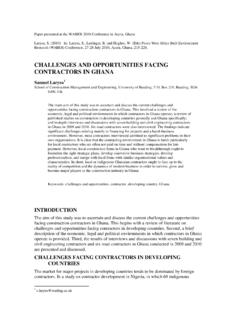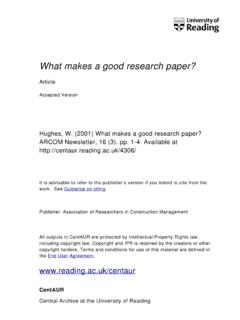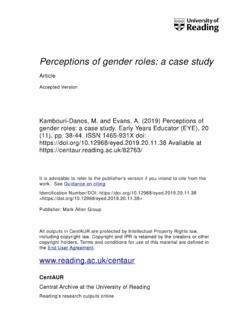Transcription of Roles in construction projects: analysis and terminology
1 Roles in construction projects: analysis and terminology Book Published Version Hughes, W. and Murdoch, J. R. (2001) Roles in construction projects: analysis and terminology . construction Industry Publications, Birmingham, pp176. ISBN 1852638982 Available at It is advisable to refer to the publisher's version if you intend to cite from the work. Publisher: construction Industry Publications All outputs in CentAUR are protected by Intellectual Property Rights law, including copyright law. Copyright and IPR is retained by the creators or other copyright holders. Terms and conditions for use of this material are defined in the End User Agreement . CentAUR Central Archive at the University of Reading Reading's research outputs online Roles in construction projects: analysis & terminology A Research Report undertaken for the Joint Contracts Tribunal Limited By Will Hughes and John Murdoch University of Reading Roles in construction projects Will Hughes and John Murdoch, University of Reading, UK.
2 ISBN 1-85263-898-2. Acknowledgements This is the final report of a research project undertaken at the University of Reading during 1998-2000, funded by the Joint Contracts Tribunal. We are indebted to the members of the steering group for their patient and diligent involvement with this project . Their comments and suggestions on earlier drafts of this report have been extremely helpful in contributing to the development of the ideas presented here. Of course, any errors or misrepresentations remain the responsibility of the authors. Our grateful acknowledgments go to: John Cooper Roland Philips Ivan Dickason peter aeberli Thanks are also due to the practitioners listed in Appendix 1 for their contribution to the focus groups. Finally, we would like to acknowledge the help of Rhoda Coombes for her excellent work in arranging focus groups and transcribing the recordings, as well as for providing enthusiastic secretarial support for the project .
3 Will Hughes and John Murdoch University of Reading, April 2001. Roles in construction projects Foreword This year (2001) celebrates the 70th anniversary of the appointment in 1931 of the Joint Contracts Tribunal by the Royal Institute of British Architects and the predecessor pf the construction Confederation, NFBTE, with the objects of keeping the Form up-to-date with modern practice and removing any difficulties which may arise in connection with its use.. It is therefore fitting for this publication to provide part of that celebration as well as a continued output of important research sponsored by the Joint Contracts Tribunal ( JCT ) through its Research Projects Committee. Much has happened since the publication of the 1931 Standard Form of Building Contract, none more so that the demands placed on the participants in the construction process. In 1998 the Research Projects Committee under the Chairmanship of my predecessor, Michael Millwood OBE, commissioned Will Hughes and John Murdoch from the Departments of construction Management and Law, respectively, at the University of Reading, to carry out research into terminology in construction contracts.
4 This work is now complete and this publication is the final report of their research. I am delighted that the Council of JCT. has agreed that the recommendations in Chapter 8 ( terminology ). should form the basis for future drafting of its contracts. This publication undoubtedly enhances JCT's portfolio. I commend its valuable recommendations and research to all who are involved in using contract specific terminology and particularly to those involved in the production of construction contracts. In the hope that a greater degree of uniformity and clarity may be achieved. Neil Smith Chairman HCT Research Projects Committee April 2001. Executive summary Standard form contracts are typically developed through a negotiated consensus, unless they are proffered by one specific interest group. Previously published plans of work and other descriptions of the processes in construction projects tend to focus on operational issues, or they tend to be prepared from the point of view of one or other of the dominant interest groups.
5 Legal practice in the UK permits those who draft contracts to define their terms as they choose. There are no definitive rulings from the courts that give an indication as to the detailed responsibilities of project participants. The science of terminology offers useful guidance for discovering and describing terms and their meanings in their practical context, but has never been used for defining terms for responsibilities of participants in the construction project management process. Organizational analysis enables the management task to be de- constructed into its elemental parts in order that effective organizational structures can be developed. Organizational mapping offers a useful technique for reducing text- based descriptions of project management Roles and responsibilities to a comparable basis. Research was carried out by means of a desk study, detailed analysis of nine plans of work and focus groups representing all aspects of the construction industry.
6 No published plan of work offers definitive guidance. There is an enormous amount of variety in the way that terms are used for identifying responsibilities of project participants. A catalogue of concepts and terms (a terminology ) has been compiled and indexed to enable those who draft contracts to choose the most appropriate titles for project participants. The purpose of this terminology is to enable the selection and justification of appropriate terms in order to help define Roles . The terminology brings an unprecedented clarity to the description of Roles and responsibilities in construction projects and, as such, will be helpful for anyone seeking to assemble a team and specify Roles for project participants. i Contents List of tables and v List of 1 Introduction .. 1. Political consensus is difficult to achieve ..2. Contract law permits drafters to define their Guidance from terminology and taxonomy ..3. Lack of independent means for defining Research Structure of the report.
7 7. 2 analysis of role descriptions in the 9. Role descriptions in construction literature ..9. Process descriptions in the construction Role descriptions in legal literature ..14. 3 Mapping Roles , responsibilities and relationships .. 17. Basic organizational theory ..17. Modelling organizational structures ..18. Elements of the mapping 4 Examination of published plans of work .. 31. Technique ..31. Basis of the organizational matrices ..32. How to read the matrices ..33. analysis ..34. JCT draft schedule of services ..37. BPF System ..47. BS 7000: 1997 Part 4 ..55. RIBA Plan of work 1964 ..61. RIBA Plan of work 2000 ..71. construction Industry construction Industry PACE GC/ Process protocol map ..97. iii 5 Summary and analysis of source documents .. 105. General comparative 105. Comparison of titles .. 107. Comparison of stages (outputs) .. 109. project definition .. 112. Design work .. 114. Contract formation .. 115. construction .. 117. Completion.
8 118. Establishing a basis for a terminology of 118. 6 Focus groups .. 120. Approach .. 120. Guidance used for moderating focus groups .. 121. Summary of focus group 124. 7 analysis of focus group transcripts .. 129. analysis of the incidences of 129. analysis of the incidence of actions (verbs).. 136. analysis of the incidence of titles (nouns) .. 141. Summary of focus group findings .. 141. 8 143. Outputs .. 144. Actions .. 153. 155. 9 References .. 169. 10 Index .. 173. Appendix 1: Focus group 181. Appendix 2: Guidance for focus group moderators .. 183. iv LIST OF TABLES AND FIGURES. Table 1: Communication links in different patterns of interaction 19. Table 2: Definitions of Roles 27. Table 3: analysis of JCT draft schedule 46. Table 4: analysis of BPF System 52. Table 5: analysis of BS 7000 60. Table 6: analysis of RIBA 1964 69. Table 7: analysis of RIBA 2000 77. Table 8: analysis of CIC scheme 83. Table 9: analysis of CIB scheme 89. Table 10: analysis of PACE GC/Works/5 96.
9 Table 11: analysis of PPM 103. Table 12: Overall summary of analysis of plans of work 106. Table 13: Comparison of titles used for responsibilities 108. Table 14: Comparison of stages described in plans of work 110. Table 15: Frequency with which outputs were mentioned 123. Table 16: Frequency with which actions were mentioned 125. Table 17: Frequency with which titles were mentioned 126. Table 18: Overall scheme of the terminology 143. Table 19: Scheme for terminology of titles in project teams 155. Figure 1: Links with consultations 19. Figure 2: Links in teamwork 19. Figure 3: Control System 21. Figure 4: The context of project activity 22. Figure 5: Decisions, stages of work, activities & operations 25. Figure 6: Hierarchy of Roles related to systems 28. Figure 7: The relationships between Roles 29. v LIST OF ABBREVIATIONS. ACE Association of Consulting Engineers BPF British Property Federation BS British Standard BSI British Standards Institution CDM construction (Design and Management) Regulations 1996.
10 CIB construction Industry Board CIC construction Industry Council JCT Joint Contracts Tribunal NHS National Health Service PACE Property Advisers to the Civil Estate PPM Process Protocol Map R 1964 RIBA Plan of Work, 1964. R 2000 RIBA Plan of Work, 2000. RIBA Royal Institution of British Architects 1 INTRODUCTION. The Joint Contracts Tribunal is the drafting body responsible for negotiating the contents of the standard forms of building contract in general use in the building industry (excluding civil engineering). It is generally accepted in the construction industry that standard forms of contract are the best way of arriving at a set of contract terms (for example, Minogue 1997). The Latham Report (1994) observes that the JCT's traditional focus on the contract between builders and their employers resulted in a plethora of mis- matched contracts for the construction project team. Latham also recommends the preparation of a consultants' agreement.


